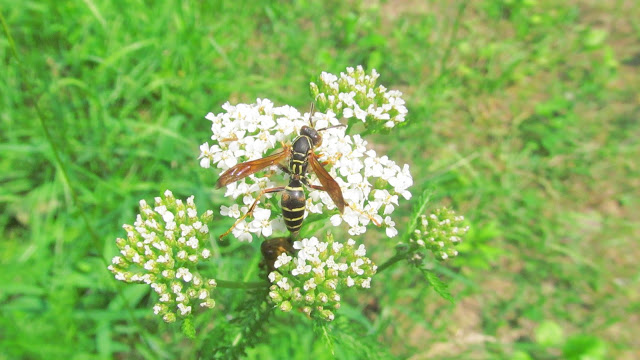On Friday we went out and collected blackberries (mostly Rubus allegheniensis, a small amount of Rubus flagellaris) and a few incidental handsful of raspberries (Rubus idaeus) and flowering raspberries (Rubus odoratus).
 |
| Our haul for the day |
Friday night, naturally, we feasted; we ate the Laetiporus sulphureus sauteed in butter and white wine, along with fresh corn (bought from the back of a farm truck, the freshest you can get without growing it yourself) and a bean salad made with the green and yellow wax beans from my father's garden. Then, of course, blackberries for desert.
But of course, that's about 12-13L in that photo, so quite a lot of blackberries. There were, therefore, enough for me to do what I really wanted: canning.
I decided to make wild blackberry jelly and wild blackberry jam. I took about 6.5L of the fruit and started by heating it up, and using a potato masher to squish the fruit:
 |
| Blackberries heating to extract juice |
 |
| Extracting the juice from the fruit |
 |
| Extracted blackberry juice |
 |
| Leftover pulp & seeds |
 |
| Cooking the jelly |
 |
| Homemade canning rack in hot water bath |
I then took the leftover pulp and revitalized it by replacing the removed juice with fruit juice (I had pomegranate & blueberry on hand so that's what I used), then adding sugar, lemon, and pectin. I cooked the lot as with the jelly, and canned the same way.
The result? 19 jars of wild blackberry jelly, and 17 jars of wild blackberry jam (36 jars total) with a large quantity of leftover jam that I turned into fridge jam which has, hilariously, mostly disappeared already even though it has only been ready for about 12 hours. It would appear that it is popular.
 |
| A few of my jars of jam and jelly |
Wild Blackberry Jelly
-7 c. wild blackberry juice
-12 c. sugar
-2 c. lemon juice (NOTE: this is to taste -- add more lemon juice if your blackberry juice is sweeter; I like a good tart jelly, but if you like it sweeter you can also reduce the lemon or increase the sugar)
-3 pouches of pectin
Yield: 19 jars
Wild Blackberry Jam
-Leftover blackberry pulp from previous stage (approx 6 c.)
-10 c. sugar
-6 c. juice (dark fruit juice is good)
-3 c. lemon juice (as above, this is to taste)
-2 pouches of pectin
Yield: 21 jars (I ran out of jars, that's why I only have 17; total volume would've filled 21)










































